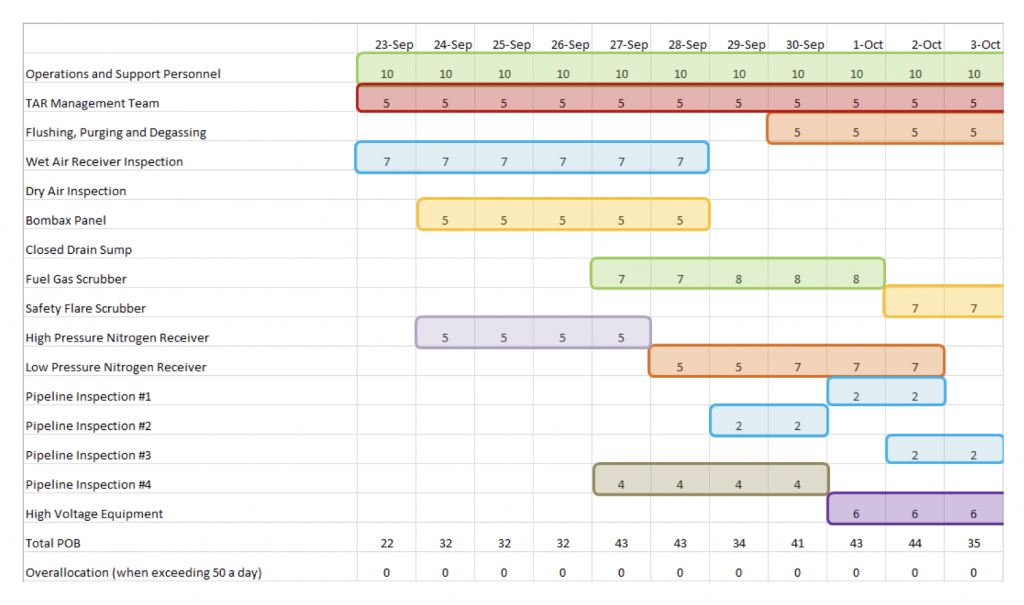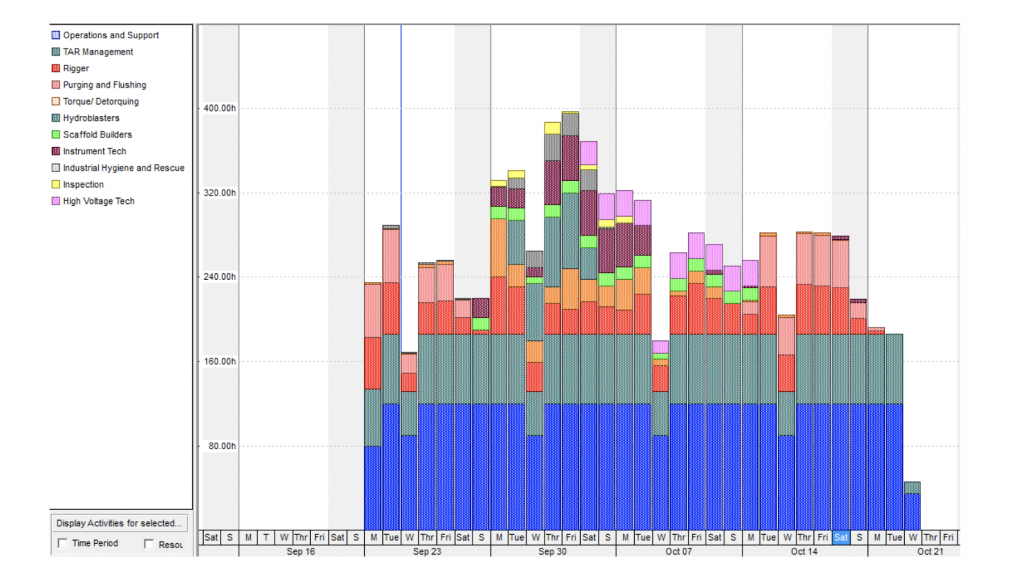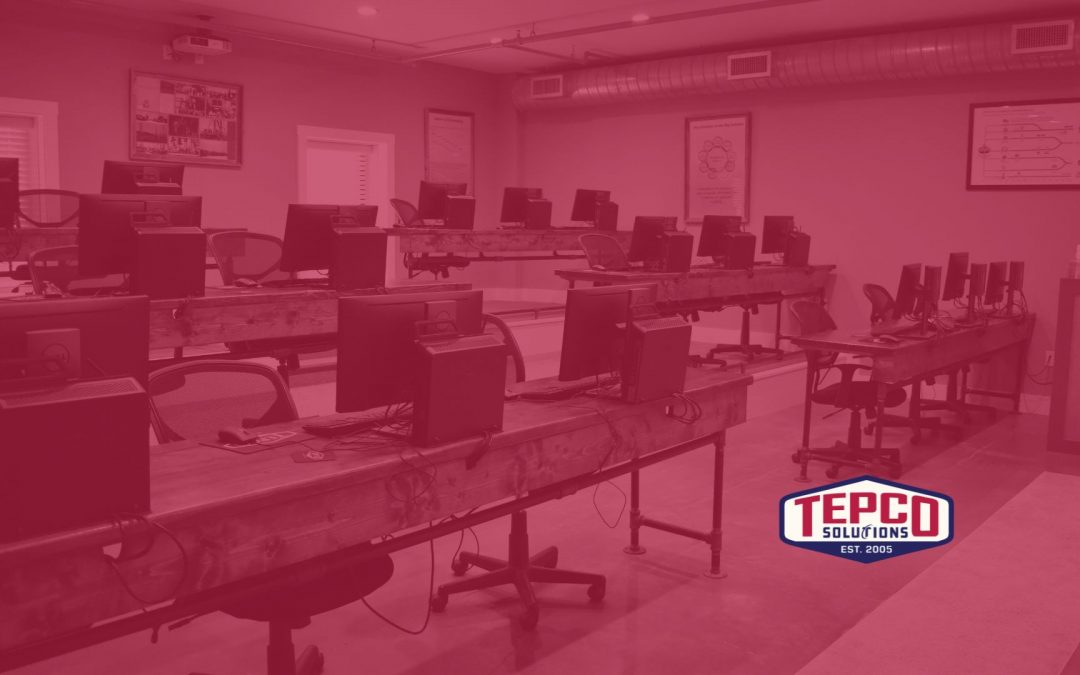Managing People On Board (POB) on Offshore Platforms
The main limitation when scheduling shutdowns or project work on an offshore platform or vessel at sea is the amount of workers that can be on the platform or vessel at any given time. An offshore platform is an isolated structure, usually miles from the coast that can only be accessed or exited by ship or helicopter. Regardless if a worker is on their active shift or their off hours, their presence on board has to be accounted for at all times in case of an emergency. Evacuation boats are installed on opposite sides of the platform allowing alternate routes of escape and a redundant number of seats are allocated for the entire crew.
The number of workers on board of a platform or vessel at sea is known as POB (people on board). This number depends on the amount of beds available onboard and the amount of seats available in the evacuation boats.
While scheduling a shutdown or a project, this POB number includes Operations and Support (in this category are the Facility Manager, Operators, Radio Operator, Paramedic and Safety Officer, Cooks, Deck Hands, Platform Crane Operators); the TAR or Project Management Team (Project Manager, Safety Officer, QAQC Inspector, Construction Manager(s) and Materials/Logistic Coordinator) and the craft personnel needed to perform the repairs or improvements required by the project. It’s necessary to maintain the Operations, Support and Management Team to the minimum amount necessary to support the crafts in a safely and efficient manner.
During the decommissioning and commissioning of the systems affected by the shutdown or project, crews in addition to the mechanical crews, will be required to blind, flush, purge, degas, pressure test and restore equipment and piping. For jobs that require confined space entry, a specialized rescue team is usually a requirement from the Safety Department. All of these additional resources should be considered when computing daily POB.
When working on the project schedule, it’s very helpful to create an Excel spreadsheet that calculates the daily POB based on the estimated amount of men per day required to complete each task. This is a time saving exercise that requires input from the planners and craft supervisors and helps the scheduler to create better relationships and sequencing between the tasks in the schedule.
Many scenarios may be considered based on priority, system availability and/or resource requirements.

After sequencing the work activities and creating the required relationships between tasks, POB requirements can be visualized in P6 by utilizing the following method:
- Create a resource named “Daily Operations and Support” and use the number of Operations and Platform Support personnel onboard as the maximum units/time.
- Create a Level of Effort activity from Shutdown Start (SS) to Shutdown Finish (FF) using that resource and the maximum units/time as the remaining units/time.
- Create a resource named “TAR Management Team” and use the number of supervision and TAR support personnel onboard as the maximum units/time.
- Create a Level of Effort activity from Shutdown Start (SS) to Shutdown Finish (FF) using that resource and the maximum units/time as the remaining units/time.

5. Build a stacked histogram showing each of the resources as a segment and placing the TAR Management Team and Daily Operations and Support Personnel at the bottom of the histogram.

Knowing that the maximum POB number is 50 and that the scheduled hours per day are 10, we can confirm visually that the daily scheduled hours don’t exceed 500 per day and in the event additional or special resources are required to complete a task, we can arrange a helicopter or boat trip to supplement the crew already onboard.
Other considerations when scheduling resources restricted by a POB:
- Rotations: Depending on the length of the project or shutdown, the different crews – Operations and Construction – could be subject to rotations, every week or two weeks; that limits the productivity for a particular day of the week. On the day the rotation takes place, the crews are transported from and to shore by boat or helicopter and the new crews go thru safety orientations and work turnovers. The calendar in P6 should be adjusted to reflect the loss of productivity on the rotation day(s).
- Special Resources: During the execution phase, special resources like Inspectors, Engineers, High Voltage Electricians, and Valve Technicians, etc. will be required to come onboard for specific tasks. It is important to emphasize in the schedule all the tasks that require a special resource and to schedule their availability onboard in an efficient manner.
- Mansleepers/Additional Beds: It is possible to install temporary living quarters to accommodate more workers on the platform or vessel at sea as long as additional boats are available for their safe evacuation in case of an emergency.
- NUI (Normally Unoccupied Installations): These are offshore platforms that are not intended for continuous occupancy and don’t provide living accommodations for Operational or Maintenance personnel. They present logistical challenges of transporting and accommodating the complete crews during the event.
- Helicopter Flights: When budget allows it, daily helicopter flights are available to transport personnel on day trips to the platform. Helicopters usually fly only during daylight hours with a maximum capacity of 7 or 8 passengers, depending on helicopter model. These flights are subject to good weather and heliport flight schedule. The cost of daily helicopter flights to the offshore platform is very high and a good schedule has to be prepared and maintained during execution to avoid unnecessary trips and delays in production.
For more information on scheduling shutdowns or project work on an offshore platform or vessel at sea, contact TEPCO to speak with one of our Field Consultants at (281) 428-3726.



